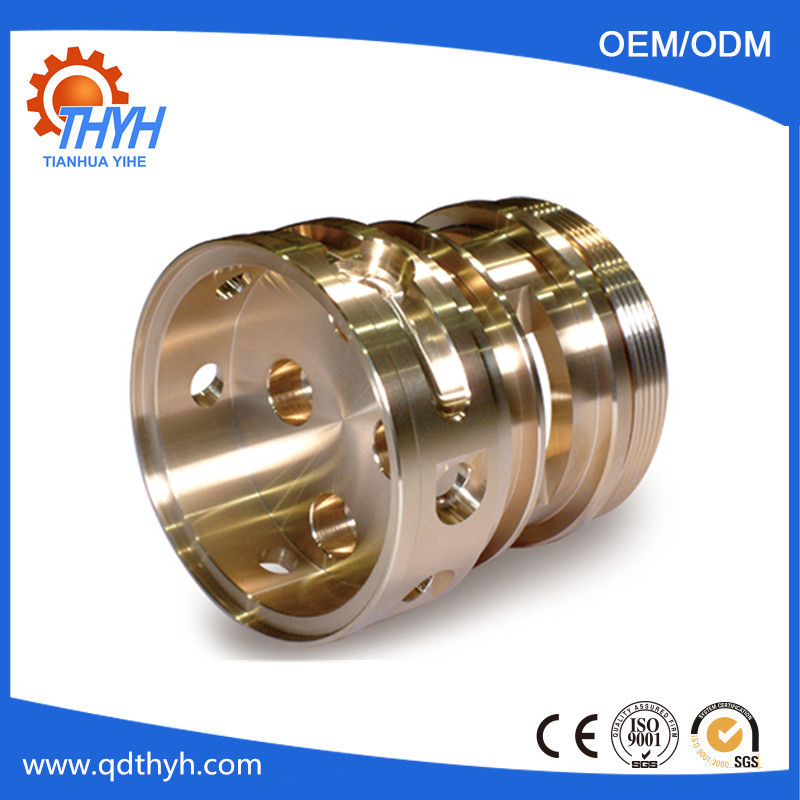Hot Keywords:
- All
- Product Name
- Product Keyword
- Product Model
- Product Summary
- Product Description
- Multi Field Search
Views: 115 Author: Qingdao TianHua YiHe Foundry Factory Publish Time: 2024-02-06 Origin: Site

Turning Process
Turning is a machining process in which a cutting tool, typically a lathe tool, is used to remove material from a rotating work piece to create a cylindrical shape. The work piece is held in place by a chuck or a collet, and the cutting tool is brought into contact with the work piece to remove material and create the desired shape. The turning process can be used to create a variety of shapes, including straight, tapered, contoured, and filleted surfaces. It is commonly used to produce cylindrical parts such as shafts, rods, and bushings. The turning process can be performed on a manual lathe or a computer numerical control (CNC) lathe, depending on the complexity and precision requirements of the part being produced.
Lathe Turning Operations
Lathe turning operations refer to the various machining processes that are performed on a lathe machine to create cylindrical shapes or perform other operations on a workpiece. Some common lathe turning operations include:
1. Facing: In this operation, the cutting tool is used to remove material from the end of the workpiece to create a flat surface perpendicular to the axis of rotation.
2. Turning: This is the most fundamental lathe operation, where the cutting tool is used to remove material from the outer diameter of the workpiece to create a cylindrical shape.
3. Taper turning: Taper turning involves cutting a workpiece so that the diameter gradually decreases or increases along its length.
4. Threading: This operation involves cutting threads on the external or internal surface of the workpiece to create a screw or bolt.
5. Grooving: In grooving, a cutting tool is used to create a narrow, linear recess or groove on the surface of the workpiece.
6. Knurling: Knurling is a process of impressing a diamond-shaped or straight-line pattern onto the surface of a workpiece to provide a better grip or aesthetic appearance.
These are just a few examples of the many operations that can be performed on a lathe machine. Each operation requires the use of specific cutting tools, tool paths, and machining parameters to achieve the desired result.
For centuries, manufacturers utilized manually operated lathes to turn manufactured parts. This type of equipment required continuous supervision by the human operator. Even today, human machinists must pay close attention to the operation of manual lathes in order to operate cutting tools safely.
Recently, many manufacturing firms have introduced fully automated computer numerical control, or “CNC”, lathes. Automated machinery can turn parts with far greater precision than a human being. While human operators must still supervise the performance of this equipment, they do not need to exercise the constant intensely focused oversight required of manual lathe operators.
A fully automated lathe enables a CNC machinist to pre-program the movements of both the cutting tool and the workpiece. Usually, this sophisticated machinery will incorporate other machining operations, as well. High quality CNC equipment can produce parts within close tolerance ranges.
Applications for Turned Parts
Turned parts enjoy popularity in numerous industries. Turning enables a manufacturer to produce desired measured rotational surfaces, tapers, grooves, slots and other contours requiring the removal of excess material from a metal part.
The applications for these components vary widely, based upon the specific part. Industrial and machine designers, automakers, furniture makers, electronic parts manufacturers and many others frequently use turning as a machining operation.
Just consider some common applications for turned parts. For instance, by using turning during manufacturing, companies may speed up the production of a prototype. Machining may help create specific rotational features on cogs or wheels. It usually plays a role in the manufacture of rotational parts and custom designed shafts and fasteners, too.
Advantages of The Turning Process
Turning as a machining process potentially offers some distinct advantages in an industrial setting.
Manufacturers can produce high quality turned parts composed from a variety of widely used materials. Most metals and metal alloys tolerate turning during the machining stage of production, for instance. This common machining process will also work very effectively for most wooden and plastic components.
Companies which employ rigorous quality control measures achieve excellent tolerances utilizing this popular machining process. Mechanized equipment turns components reliably and precisely. Skilled human machinists usually develop the ability to produce parts within good tolerance levels, although automated machines perform more reliably.
Turning as an industrial machining process does not necessarily require long periods of time to accomplish. If manufacturers maintain machining equipment in good operating condition, and do not experience extensive “down time”, companies can supply turned metal components with comparatively short lead times. This machining process facilitates the production of certain prototypes, for instance.
Many metal turned parts display excellent surface qualities, depending upon the nature of the metal or metal alloy used by the manufacturer. Metal part makers may choose to perform finishing after machining using turning, or not.
Depending upon the size of the parts and the equipment involved, machining using turning may require less energy expenditure than some other types of machining processes. Numerous manufacturers have chosen to automate this process in the production of high quality metal parts. Human machinists also perform turning manually in some manufacturing environments.
High quality turning tools typically enjoy a relatively long tool life in modern industrial settings. This factor potentially contributes to the cost-effectiveness of turned parts.
Contact Qingdao TianHua YiHe Foundry Factory
For further information about our services, contact us via the convenient website form or submit a request for quote directly.
We welcome your inquiries.